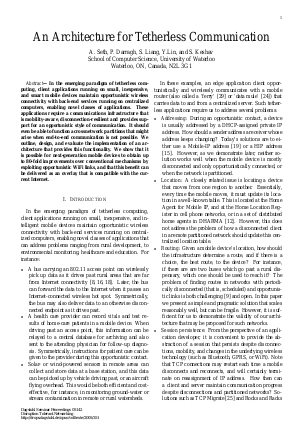An Architecture for Tetherless Communication
Authors Aaditeshwar Seth, Patrick Darragh, Suihong Liang, Yunfeng Lin, Srinivasan Keshav
-
Part of:
Volume:
Dagstuhl Seminar Proceedings, Volume 5142
Part of: Series: Dagstuhl Seminar Proceedings (DagSemProc) - License:
 Creative Commons Attribution 4.0 International license
Creative Commons Attribution 4.0 International license
- Publication Date: 2005-11-16
File

PDF
DagSemProc.05142.3.pdf
- Filesize: 201 kB
- 13 pages
Document Identifiers
Subject Classification
Keywords
- Delay tolerant networks
- Opportunistic communication
- Tetherless computing
- Wireless
- Mobile
Metrics
- Access Statistics
-
Total Accesses (updated on a weekly basis)
0PDF Downloads0Metadata Views
Abstract
In the emerging paradigm of tetherless computing, client applications running on small, inexpensive, and smart mobile devices maintain opportunistic wireless connectivity with back-end services running on centralized computers, enabling novel classes of applications. These applications require a communications infrastrastructure that is mobility-aware, disconnection-resilient and provides support for an opportunistic style of communiction. It should even be able to function across network partitions that may arise when end-to-end communication is not possible. We outline, design, and evaluate the implementation of an architecture that provides this functionality. we shot that it is possible for next-generation mobile devices to obtain up to 80-fold improvement over conventional mechanisms by exploiting opportunistic WiFi links, and that this benefit can be delivered as an overlay that is compatible with the current Internet.
Cite As Get BibTex
Aaditeshwar Seth, Patrick Darragh, Suihong Liang, Yunfeng Lin, and Srinivasan Keshav. An Architecture for Tetherless Communication. In Disruption Tolerant Networking. Dagstuhl Seminar Proceedings, Volume 5142, pp. 1-13, Schloss Dagstuhl – Leibniz-Zentrum für Informatik (2005)
https://doi.org/10.4230/DagSemProc.05142.3
BibTex
@InProceedings{seth_et_al:DagSemProc.05142.3,
author = {Seth, Aaditeshwar and Darragh, Patrick and Liang, Suihong and Lin, Yunfeng and Keshav, Srinivasan},
title = {{An Architecture for Tetherless Communication}},
booktitle = {Disruption Tolerant Networking},
pages = {1--13},
series = {Dagstuhl Seminar Proceedings (DagSemProc)},
ISSN = {1862-4405},
year = {2005},
volume = {5142},
editor = {Marcus Brunner and Lars Eggert and Kevin Fall and J\"{o}rg Ott and Lars Wolf},
publisher = {Schloss Dagstuhl -- Leibniz-Zentrum f{\"u}r Informatik},
address = {Dagstuhl, Germany},
URL = {https://drops.dagstuhl.de/entities/document/10.4230/DagSemProc.05142.3},
URN = {urn:nbn:de:0030-drops-3519},
doi = {10.4230/DagSemProc.05142.3},
annote = {Keywords: Delay tolerant networks, Opportunistic communication, Tetherless computing, Wireless, Mobile}
}
